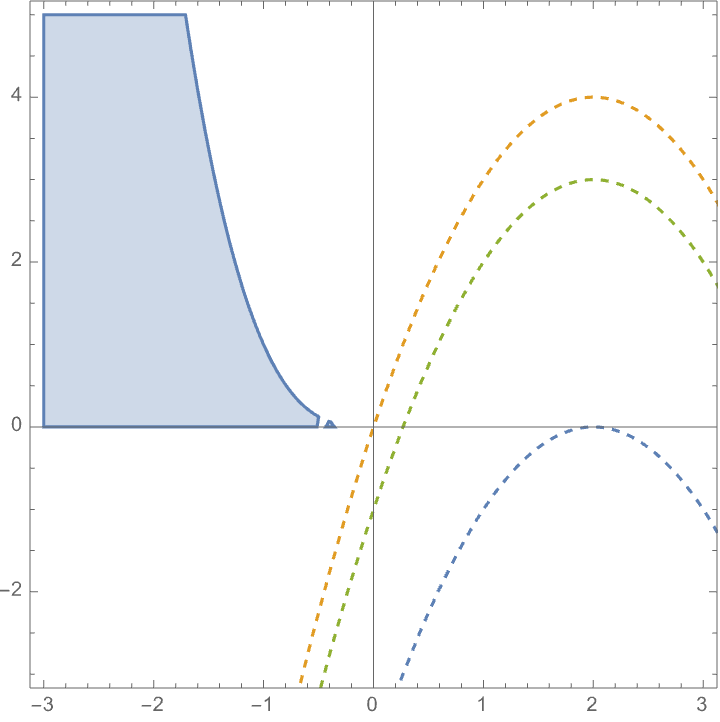Good morning everybody. First of all, I apologise to ask here the same question I asked on MSE three days ago, but I am in fact re-asking since I obtained no relevant advice. Perhaps I will hear some hints from you people. I kept thinking and re-doing this problem, updating with "thoughts" but I arrived to a dead end. Any help will be very appreciated, thanks.
Find the minimum of $f(x, y) = (x-2)^2 + y$ subject to $y-x^3 \geq 0$, $y+x^3 \leq 0$ and $y \geq 0$.
Now, I solved the problem in a sketching way: the level curves of $f(x, y)$ are concave parabolas ($y = k - (x-2)^2$), and the feasible region is the upper left plane bounded by $x<0$-axis and under the curve $-x^3$. The candidate solution is $(0, 0)$ at which $f(x, y) = 4$.
On the other side, I wanted to solve it with Kuhn-Tucker multipliers, so I set the problem in the standard form for a minimum problem that is:
$$-\max -f(x, y) \qquad \text{s.t.} \qquad \begin{cases} -y+x^3 \leq 0 \\ y+x^3 \leq 0 \\ -y \leq 0 \end{cases}$$ with KKT Lagrangian
$$L = -(x-2)^2-y- \lambda(-y+x^3) - \mu(y+x^3) - \Theta(-y)$$
which leads to the optimal conditions $$ \begin{cases} -2(x-2) - 3\lambda x^2 - 3\mu x^2 = 0 \\ -1+\lambda - \mu + \Theta = 0 \\ -y + x^3 \leq 0 \quad ; \quad \lambda(-y+x^3) = 0 \\ y+x^3 \leq 0 \quad ; \quad \mu(y+x^3) = 0 \\ -y\leq 0 \quad ; \quad \Theta y = 0\\ \lambda, \mu, \Theta \geq 0 \end{cases} $$ From here I have to study $8$ cases. Here are some:
$\bullet$ When $\lambda = \mu = \Theta = 0$ the system is impossible.
$\bullet$ When $\lambda = \mu = 0$, $\Theta \neq 0$ I obtain $(2, 0)$ which doesn't satisfy the constraints.
$\bullet$ When $\lambda = 0$, $\mu \neq 0, \Theta = 0$ I get $\mu = -1$ which is not admissible.
$\bullet$ When $\lambda, \mu, \Theta \neq 0$ I eventually manage to get among the others $$\begin{cases} \Theta = \mu + 1 - \lambda \\ (\mu+1-\lambda)y = 0 \end{cases} $$ From which either $y =0$ or $\lambda = \mu +1$.
For $\lambda = \mu +1$ using the first equation I get $$\mu = \frac{4-2x-3x^2}{6x^2}$$ from which $$\lambda = \frac{4 - 2x + 3x^2}{6x^2}$$ If $y = 0$ then from the complementarity equation $\mu(x^3-y) = 0$ I obtain $(4-2x-3x^2)x = 0$, hence either $x = 0$ or $x = \frac{1}{3}(-1\pm \sqrt{13})$, but those last ones don't satisfy all the constraints.
On the other side, $x = 0$ would be good if not for the fact that I cannot take it since it would make $\lambda, \mu$ nonsensical.
So I ask you: how to deal with this problem analytically? It looks like KKT conditions might not be satisfied, but I am not sure of this. I would like other pairs of eyes/mind from you, thank you!
Here is the sketch too, with Mathematica code. It's not as good as I thought, since the feasible region should include a missing portion (the origin to the left and above).
plot1 = RegionPlot[{y - x^3 >= 0 && y + x^3 <= 0 && y >= 0}, {x, -3, 3}, {y, -3, 5}, Axes -> True] plot2 = Plot[{-(x - 2)^2, 4 - (x - 2)^2, 3 - (x - 2)^2}, {x, -3, 5}, PlotStyle -> {Dashed, Dashed, Dashed}] Show[plot1, plot2] Second Thought
Or maybe I just could say that $y \leq -x^3$ is the same as $-y \geq x^3$ but this, with the other condition implies $\begin{cases} x^3 \leq -y \\ x^3 \leq y \end{cases}$ could just imply either $x = 0$ and then $y = 0$, or $y = 0$ and $x$ must be negative, though in this last case we would keep increasing the value of $f$ rather than find the minimum.
Third Thought
I perhaps have forgotten about the regularity of the constraints. The Jacobian matrix indeed reads
$$\mathsf{J} = \begin{pmatrix} 3x^2 & -1 \\ 3x^2 & 1 \\ 0& -1 \end{pmatrix}$$
From which we observe that at $(0, 0)$ we lose the regularity of the constraitns, being $\mathsf{J}$ of randk $1$.
Perhaps this is what makes KKT conditions to not being satisfied.
In any case, the problem with the solution $x = 0$ remains: it is not valid since it makes $\lambda, \mu$ nonsensical.
Fourth Thought
By analysing the cas in which only $\Theta = 0$ I may have gotten the solution $(0,0)$, which now doesn't carry any weird behaviour for $\mu$ \nad $\lambda$.
The question on the KKT conditions still remains, but perhaps it's indeed the non regularity of the constraints the answer, which accurs at $x = 0$ and $y =0$.
Fifth Thought
I didn't notice before, but the solution $x = 0$, $y =0$ makes the gradient system impossible: the first equation would read $4 = 0$.
At this point I have no more ideas about this exercise...

